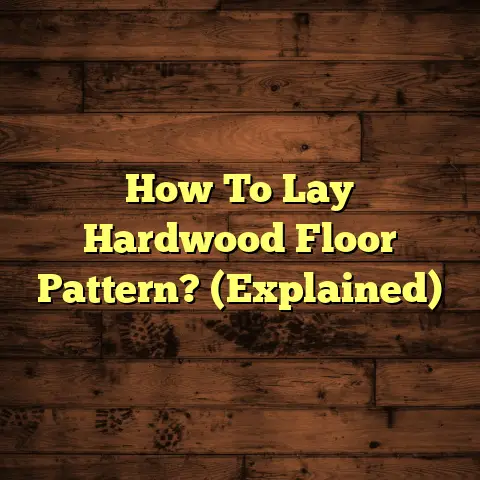Protect Floors From Furniture: How? (3 Steps!)
I’m a flooring contractor, and if there’s one thing I’ve seen a lot of, it’s beautiful floors getting beat up by… you guessed it, furniture.
We all invest good money in our floors, right?
Whether it’s gleaming hardwood, elegant tile, cozy carpet, or even that super-durable laminate, it’s an investment!
So, protecting that investment is key!
I’ve seen everything from tiny scratches to deep gouges that could’ve been avoided with a little foresight.
That’s why I’m here to walk you through three simple, but super effective steps you can take to keep your floors looking fantastic, longer.
Let’s dive in!
Step 1: Choose the Right Furniture Pads
Okay, this might seem like a no-brainer, but trust me, the type of furniture pad you use makes a HUGE difference.
Think of furniture pads as tiny bodyguards for your floor!
They create a buffer between your furniture and the surface, preventing scratches, dents, and scuffs.
But not all bodyguards are created equal, right?
Let’s break down the different types:
Understanding Different Types of Pads
-
Felt Pads:
These are your everyday heroes. I recommend felt pads for hardwood, laminate, and tile floors.
They’re soft and gentle, preventing those annoying scratches that appear over time.
Think of them as little cushions for your furniture legs!
I’ve personally used felt pads on my own hardwood floors for years and they’ve saved me countless headaches.
-
Rubber Pads:
Got heavier furniture? Rubber pads are your go-to!
They offer a fantastic grip, preventing furniture from sliding around, especially on tile and vinyl.
Plus, they absorb impact, reducing the risk of cracking tiles.
I’ve used them under heavy bookshelves and entertainment centers, and they work wonders!
-
Plastic Pads:
These are more specialized. I typically recommend them for furniture with legs that tend to dig into softer surfaces, like carpets or rugs.
They distribute the weight more evenly, preventing those dreaded indentations.
I’ve even seen people use them under the legs of their bed frames on carpet to prevent permanent impressions.
Here’s a quick rundown in a handy table:
| Pad Type | Best For | Benefits |
|---|---|---|
| Felt | Hardwood, Tile | Prevents scratches, soft buffer |
| Rubber | Heavy Furniture | Grips floor, prevents slipping, impact absorption |
| Plastic | Carpet, Rugs | Prevents dents, weight distribution |
How to Apply Furniture Pads
Alright, you’ve got your pads, now what?
Applying them correctly is key to getting the most out of them.
Here’s my step-by-step guide:
-
Clean the Furniture Leg:
This is crucial! Make sure the bottom of the furniture leg is clean and dry.
Any dirt or debris can prevent the pad from sticking properly.
I usually wipe them down with a damp cloth and let them dry completely.
-
Measure and Cut (If Necessary):
Some pads come in pre-cut sizes, but others you’ll need to trim.
Measure the diameter of the furniture leg and cut the pad to the appropriate size.
You want the pad to fit snugly under the leg without any overhang.
-
Stick ‘Em On!
Peel off the backing and stick the pad onto the bottom of the leg.
Apply firm pressure for a few seconds to ensure it adheres well.
I like to give it a good press for about 30 seconds just to be sure.
Regular Maintenance of Pads
Don’t just stick ’em on and forget about them!
Regular maintenance is important to ensure they continue to do their job.
-
Check for Wear and Tear:
Inspect your furniture pads regularly.
If they’re worn down, flattened, or peeling off, it’s time to replace them.
I usually check mine every few months.
-
Keep the Floor Clean:
Even with pads, dirt and debris can still scratch your floors.
Sweep or vacuum regularly to keep the area around your furniture clean.
I’m a big fan of those robot vacuums for keeping things tidy!
Step 2: Implement Smart Furniture Arrangement
Okay, so you’ve got your furniture pads in place. Awesome!
But protecting your floors is about more than just pads.
The way you arrange your furniture can also have a HUGE impact.
Think of it as interior design with floor protection in mind!
Avoid Heavy Concentration of Furniture
-
Distribute the Weight:
Don’t cram all your heavy furniture into one area of the room.
Distributing the weight evenly across the floor prevents excessive wear in specific spots.
I’ve seen floors with permanent indentations under sofas that have been in the same spot for years!
-
Consider Traffic Flow:
Think about how people move through your home.
Arrange furniture to create clear pathways, reducing the likelihood of people dragging chairs or bumping into tables.
I always try to create a natural flow that encourages people to walk around furniture, not through it.
Utilize Area Rugs
-
Protection and Style:
Area rugs are your friends! They not only enhance your room’s decor but also provide a protective layer between your furniture and the floor.
I always tell my clients that rugs are like “floor insurance”!
-
Non-Slip Underlays are Key:
Make sure your rugs are secured with non-slip underlays.
This prevents them from moving or bunching, which could lead to accidents.
Plus, a slipping rug isn’t protecting anything!
I’ve seen people trip over rugs more times than I can count, so don’t skip this step!
Rearranging Furniture Periodically
-
Even Wear:
This is a pro tip! Shift your furniture every few months to avoid creating permanent indentations in the flooring, especially in carpets and softer wood floors.
It’s like rotating your tires to ensure even wear.
-
Aesthetic Refresh:
Plus, rearranging your furniture can give your space a fresh, new look!
It’s a win-win!
I personally love rearranging my living room every season.
Step 3: Mindful Movement Techniques
Alright, you’ve got your pads, you’ve arranged your furniture smartly…
But even with all that, the way you move furniture can still cause damage.
Think of it as driving a car. You can have the best car in the world, but if you drive recklessly, you’re still going to end up with dents and scratches!
Lifting vs. Dragging
-
Always Lift!
This is the golden rule! When moving furniture, always lift rather than drag.
Dragging is a surefire way to create scratches and scuff marks on hard surfaces.
I cringe every time I see someone dragging a chair across a hardwood floor!
-
Get Help or Use Sliders:
Enlist the help of others or use furniture sliders to make lifting easier and safer.
Don’t try to be a hero and move a heavy sofa by yourself!
I always have a set of furniture sliders handy for those occasions.
Using Furniture Sliders
-
Smooth Movement:
Invest in furniture sliders that can be placed under the legs of chairs, tables, and sofas to facilitate smooth movement across the floor.
They’re like little ice skates for your furniture!
-
Minimize Direct Contact:
This technique minimizes direct contact with the flooring, reducing the chance of damage.
I’ve used them to rearrange entire rooms without leaving a single scratch.
Plan for Seasonal Changes
-
Humidity and Temperature:
During seasonal transitions, consider how humidity and temperature changes can affect flooring materials, especially wood.
Wood expands and contracts with changes in humidity, which can put stress on your furniture and your floors.
According to the National Wood Flooring Association (NWFA), maintaining a consistent humidity level is crucial for preserving hardwood floors. They recommend a relative humidity of 30-50%.
-
Adjust Accordingly:
Plan your furniture arrangement and movement accordingly to minimize stress on the flooring.
For example, in the winter, when the air is drier, you might want to avoid placing heavy furniture near heat sources.
Conclusion
Protecting your floors from furniture damage is a critical aspect of maintaining the beauty and longevity of your home’s flooring.
It’s like taking care of your car or maintaining your garden.
It requires a little effort, but the rewards are well worth it.
By implementing these three steps—choosing the right furniture pads, arranging furniture thoughtfully, and employing mindful movement techniques—you can help ensure that your upgraded flooring remains in excellent condition for years to come.
With a little effort and attention, you can enjoy your stylish and functional living space without the worry of damaging your floors.
I hope this article has been helpful! Remember, a little prevention goes a long way.
Happy flooring!





